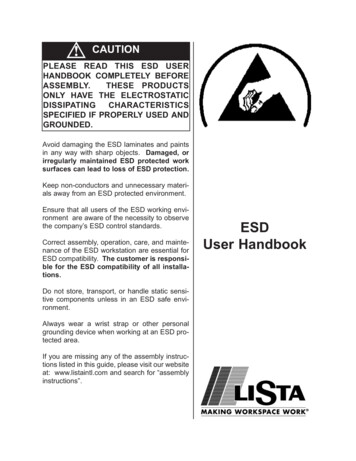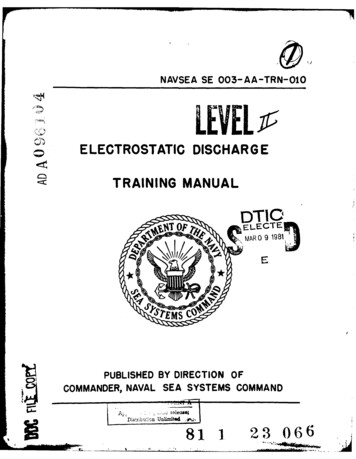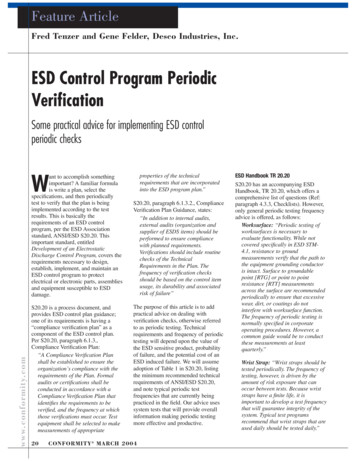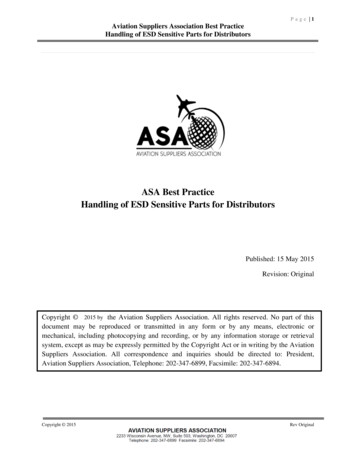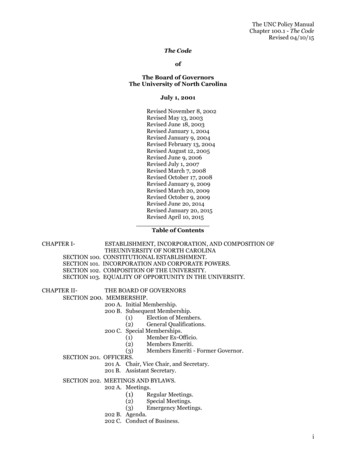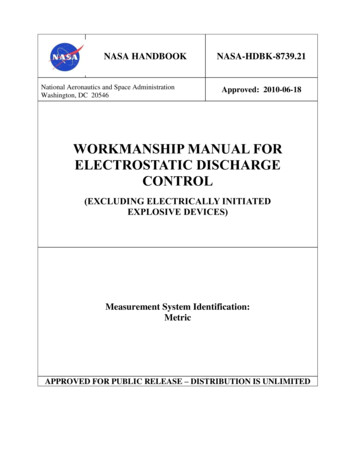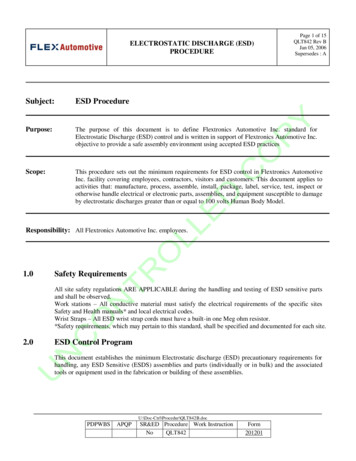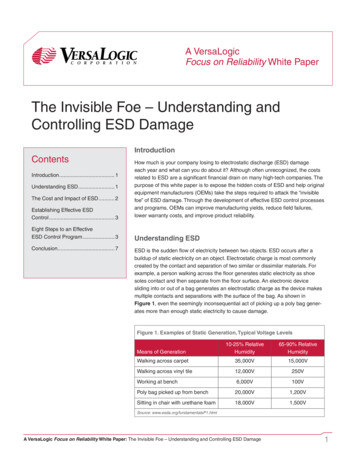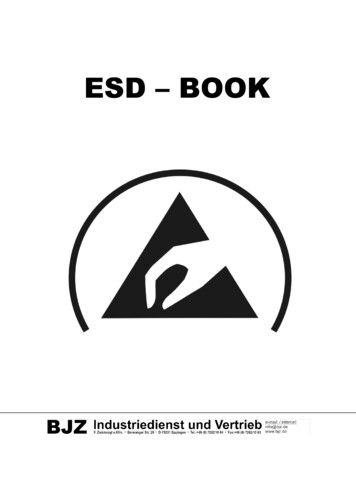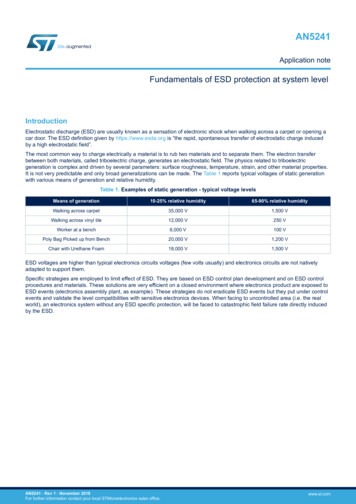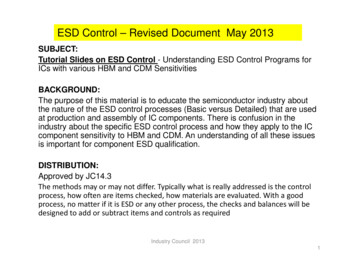
Transcription
ESD Control – Revised Document May 2013SUBJECT:Tutorial Slides on ESD Control - Understanding ESD Control Programs forICs with various HBM and CDM SensitivitiesBACKGROUND:The purpose of this material is to educate the semiconductor industry aboutthe nature of the ESD control processes (Basic versus Detailed) that are usedat production and assembly of IC components. There is confusion in theindustry about the specific ESD control process and how they apply to the ICcomponent sensitivity to HBM and CDM. An understanding of all these issuesis important for component ESD qualification.DISTRIBUTION:Approved by JC14.3The methods may or may not differ. Typically what is really addressed is the controlprocess, how often are items checked, how materials are evaluated. With a goodprocess, no matter if it is ESD or any other process, the checks and balances will bedesigned to add or subtract items and controls as requiredIndustry Council 20131
Background Basic ESD Control is mandatory across thesemiconductor industry for handling ICcomponents Detailed ESD Control is gradually becomingimportant for the industry There has been some confusion about theextent of these programs as the new ESDlevels are established for IC qualification The difference which will be discussed later is really the understanding of how effectivethese controls are, regardless of the standard used.Industry Council 20132
Purpose The purpose is to clarify the issues of“Basic” versus “Detailed” ESD control Describe the HBM and CDM levels at whichthese specific programs applyIndustry Council 20133
Basic ESD Control Program Avoid personnel charging and discharging into the device bygrounding personnel Avoid discharges between different items by handling themonly when they are at the same potential, e.g. by using ESDsafe work surfaces Use ESD safe packaging materials when removingdevices from the ESD safe workplace Electronics manufacturers use at least this level across theglobe, while most do more than this basic level.The point here is that when using existing ESD control a process engineerdoes not need to understand how these items work in order to achieve theselevels of control.Industry Council 20134
Basic ESD Control Program If the precautions described in the bullets below arefollowed, the charge on personnel and work surfaceswill be less than 100V. This means it is clearly safe to handle devices with anHBM robustness 500V Personnel Grounding through wrist straps or properlyselected footwear/flooring system Grounded work surfaces ESD-safe Packaging Materials If these are not fulfilled, the control program has nomeaning and even 2kV HBM devices may be injeopardy.The point here is that using existing ESD control, a process engineerdoes not need to understand how these items work in order to achievethese levels of control.Industry Council 20135
CDM Control CDM control requires additional steps of control of chargingof devices by Controlling insulators Controlling charging of boards/devices during processing Avoiding hard (metal-to-metal) discharges Many basic ESD control elements like dissipative worksurfaces reduce the CDM risk Programs following above requirements have CDM controlintrinsically implemented (process analysis may be required)While these are good things to say, most process engineers do not understand how they are controlling the charging ofboards or avoiding metal to metal discharges. Some engineers use dissipative work surfaces to reduce CDM risk butforget to address other incidences of metal-metal contact which cannot be easily solved using these materials. Anexample is placing a device onto a circuit board there is a metal to metal contact between the connection and solderpads.Industry Council 20136
ESD Controls Summary 1. General ESD Control includes:– Basic ESD Control Grounded Personal Static Safe Workstation Packing (Safe Packaging Materials)– CDM Control Controlling insulators Controlling charged boards/devices Avoiding hard discharges 2. Detailed ESD Control includes:– Better understanding of the above processesIndustry Council 20137
Detailed ESD Control Program For IC devices with 500V HBM or 250VCDM, more detailed control programs arenecessary Detailed ESD control programs may have redundant elements to give higher safety incase one element fails compliance verification programs based onmaterials used data to prove the program worksThe real point (data to prove the program works) is the most important. Many times it isrealized that after a careful evaluation, an existing program is fine the way it is to handle moresensitive items. So one does not want to say that more or more frequent things are requiredunless they are based on some facts or data analysisIndustry Council 20128
General ESD Control includes CDM SpecificGeneral ESD ControlBasic ESD Control: Grounding Table Mats Safe Packaging MaterialsBasic CDM Control: Control of InsulatorsData indicates that with these controls in place devicesare safe to: 500V HBM and 250V CDMIndustry Council 20139
For Sensitive HBM / CDMDetailed ESD ControlFor Sensitive HBM: Must follow S20.20 IEC 61340-5-1 Or JESD625BFor Sensitive CDM: Must follow all items of abovestandards Must include detailed and extendedverificationNo matter which standard is selected, with a better understanding of the ESD control process,the elements in these standards still apply.Industry Council 201310
HBM Table*HBM Level of ICImpact on Manufacturing Environment2 KV1 kV500 V100 V to 500 VBasic ESD Control methods allow safemanufacturing with proven marginDetailed ESD Control methods are requiredBasic Programs: Include wrist straps, grounded work surfaces,and safe packaging materials, and are safe with proven margin to500V.Detailed Programs: ANSI/ESD S20.20 or IEC-61340-5-1 arecomprehensive program standards patterned on ISO9000 and canbe basis for facility certification. JESD625 is widely used in the ICindustry. Implementation of these standards provides protectionof devices with at least HBM 100 volts and probably lower.* Published as part of JEP155Industry Council 201311
CDM Table **Published as JEP157Industry Council 201312
Summary (1) Basic ESD Control– Any electronic manufacturer has to follow at least basiccontrols– The basic program can be Following one of the known standards A customized in-house program following the basic controlrequirements– With either of the above basic programs, 1kV HBM devicesare safe and should require no additional precautions– Variations in the basic programs for different productionareas is of no concern in the change from 2kV to 1kV HBM– Vast amounts of industry data for the last 10 yearssupports the conclusion that even 500V HBM devices aresafe if the basic program is followedIndustry Council 201313
Summary (2) General ESD Control– Includes both Basic ESD and CDM controls– General CDM steps are basic in nature andare always important regardless of thedevices’ HBM performance– With the General ESD Control in place, 500V HBM and 250V CDM are safeIndustry Council 201314
Summary (3) Detailed ESD Control– Comply with S20.20 or IEC 61340-5-1, andCDM elements of JESD625– Requires regular compliance verification– With the advent of advanced technology ICdevices, majority of the industry is progressingtowards these detailed steps– Effective implementation of these programs areintended to provide protection for devices with 100V HBM and 100V CDMIndustry Council 201315
the nature of the ESD control processes (Basic versus Detailed) that are used at production and assembly of IC components. There is confusion in the industry about the specific ESD control process and how they apply to the IC component sensitivity to HBM and CDM. An understanding of all these issues is important for component ESD qualification.
